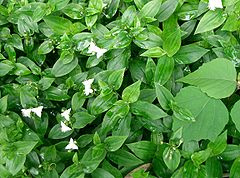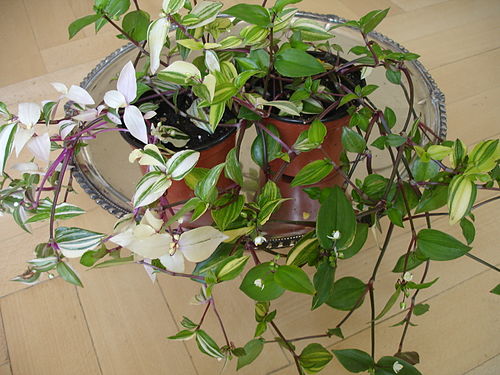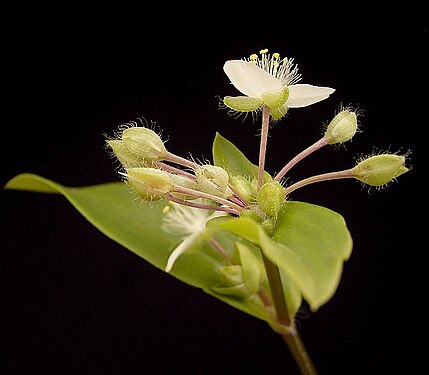Difference between revisions of "Tradescantia fluminensis"
| (2 intermediate revisions by 2 users not shown) | |||
| Line 1: | Line 1: | ||
| − | + | {{SPlantbox | |
| − | | | + | |familia=Commelinaceae |
| − | | | + | |genus=Tradescantia |
| − | | | + | |species=fluminensis |
| − | | | + | |common_name=River Spiderwort, Small-Leaf Spiderwort, Inch Plant, Wandering Jew/Willie |
| − | | | + | |habit=herbaceous |
| − | | | + | |Min ht box=12 |
| − | | | + | |Min ht metric=in |
| − | | | + | |Max ht box=20 |
| − | | | + | |Max ht metric=in |
| − | + | |height_ref=Flora - A Gardener's Encyclopedia | |
| − | | | + | |Min wd box=24 |
| − | | | + | |Min wd metric=in |
| − | | | + | |Max wd box=60 |
| − | | | + | |Max wd metric=in |
| − | | | + | |width_ref=Flora - A Gardener's Encyclopedia |
| − | | | + | |origin=Brazil, Argentina |
| − | | | + | |lifespan=perennial |
| − | | | + | |exposure=part-sun, shade |
| − | | | + | |water=wet, moist |
| − | | | + | |features=naturalizes, invasive, foliage |
| − | | | + | |flowers=white |
| − | | | + | |Temp Metric=°F |
| − | | | + | |min_zone=9 |
| − | | | + | |max_zone=11 |
| − | | | + | |sunset_zones=12-28, indoors |
| − | | | + | |image=Tradescantia fluminensis1.jpg |
| − | + | |image_width=240 | |
| − | |||
}} | }} | ||
| + | '''''Tradescantia fluminensis''''' is a species of [[spiderwort]] native to South America more commonly known as ''[[Wandering Jew (disambiguation)|Wandering Jew]]'', a name it shares with closely related species ''[[Tradescantia pallida|T. pallida]]'' and ''[[Tradescantia zebrina|T. zebrina]]''. | ||
| + | |||
| + | Though often grown in the [[United States]] as a [[garden]] plant or [[houseplant]], in many places ''T. fluminensis'' is considered an [[invasive species]], noxious [[weed]], or pest plant and is consequently targeted for eradication. | ||
| + | |||
| + | The seriously invasive qualities of ''T. fluminensis'' result from a combination of attributes. Forming a dense mat underneath [[forest]] [[tree]] cover (facilitated by a remarkable shade tolerance), it smothers ground-level plants and prevents the natural regeneration of taller species; if left unchecked, it can lead to the destruction of native forests. Even where the [[climate]] does not permit ''T. fluminensis'' to take [[root]], it still can spread rapidly from being transported by animals and humans. The [[succulent]] [[Plant stem|stems]] break easily at the nodes and establish themselves wherever they land on moist [[soil]]. While ''T. fluminensis'' does respond to [[herbicide]]s and other applied weed controls, each segment has the ability to [[Regeneration (biology)|regenerate]], so it is able to make a rapid comeback, especially in soft soils where stems may remain underneath the surface. Constant deployment of weed-control agents may have a negative effect upon the local environment, so the only option remaining is manual clearance. This is not necessarily as arduous as it may seem, since an initial clearance performed by simply raking the area will have a significant impact. With repeated efforts, each at intervals of a couple months, complete eradication is possible. Regular monitoring of invasion from neighbouring areas is indicated. | ||
| + | |||
{{Inc| | {{Inc| | ||
| − | Tradescantia fluminensis, Veil. (T. mundula, Kunth. T. albiflora, Kunth. T. repens, T. repens vittata, T. viridis, T. viridis vittata, T. viridis Goeschkei, T. prostrata, T. procumbens, T. striata, Hort. T. tricolor, Hort., in part. T. myrtiflora, Hort.). Wandering Jew in part | + | Tradescantia fluminensis, Veil. (T. mundula, Kunth. T. albiflora, Kunth. T. repens, T. repens vittata, T. viridis, T. viridis vittata, T. viridis Goeschkei, T. prostrata, T. procumbens, T. striata, Hort. T. tricolor, Hort., in part. T. myrtiflora, Hort.). Wandering Jew in part. Glabrous, with shining sts. and lvs., the nodes conspicuous, trailing, or the ends of the shoots ascending: lvs. ovate-acute, without distinct petiole, ciliate at the very base, the sheaths 1/4 – 3/8 in. long: fls. white, hairy inside, the 6 stamens all alike, borne several together in a sessile cluster subtended by 2 unequal lvs. or bracts, the pedicels not all of same age. Cent. Brazil to Argentina.— One of the commonest of greenhouse and basket-plants. In greenhouses, usually grown under the benches. When the plants grow very vigorously and have little light, they are usually green, and this is the form commonly known as T. viridis. There are forms with lvs. striped yellow and white, but these colors usually do not hold unless there is abundance of sunlight. In light places, the lvs. become red-purple beneath. Very easily prop. by cuttings or pieces of shoots at any time of the year. The plant needs plenty of moisture in order to grow vigorously. Three plants are known as wandering Jew, and although they belong to 3 genera, it is not easy to tell them apart when not in flower. These plants are Tradescantia fluminensis, sheaths hairy or ciliate only at the top, fls. white; Zebrina pendula, sheaths hairy throughout or at least at base and top, lvs. redder beneath and always colored above, fls. rose-red; Commelina nudiflora, sheaths glabrous, fls. blue. The first two are tender to frost; the last is hardy in the open ground in Cent. N. Y. All of them are used for baskets and vases. The first two are best known and are the plants commonly called wandering Jew. All of them may have striped foliage. |
{{SCH}} | {{SCH}} | ||
}} | }} | ||
| Line 64: | Line 69: | ||
{{stub}} | {{stub}} | ||
| − | + | __NOTOC__ | |
| − | |||
| − | |||
Latest revision as of 21:12, 28 April 2010
| Habit | herbaceous
| |
|---|---|---|
| Height: | ⇕ | 12 in"in" can not be assigned to a declared number type with value 12. to 20 in"in" can not be assigned to a declared number type with value 20. |
| Width: | ⇔ | 24 in"in" can not be assigned to a declared number type with value 24. to 60 in"in" can not be assigned to a declared number type with value 60. |
| Lifespan: | ⌛ | perennial |
| Origin: | ✈ | Brazil, Argentina |
| Exposure: | ☼ | part-sun, shade |
|---|---|---|
| Water: | ◍ | wet, moist |
| Features: | ✓ | naturalizes, invasive, foliage |
| USDA Zones: | 9 to 11 | |
| Sunset Zones: | 12-28, indoors | |
| Flower features: | ❀ | white |
Tradescantia fluminensis is a species of spiderwort native to South America more commonly known as Wandering Jew, a name it shares with closely related species T. pallida and T. zebrina.
Though often grown in the United States as a garden plant or houseplant, in many places T. fluminensis is considered an invasive species, noxious weed, or pest plant and is consequently targeted for eradication.
The seriously invasive qualities of T. fluminensis result from a combination of attributes. Forming a dense mat underneath forest tree cover (facilitated by a remarkable shade tolerance), it smothers ground-level plants and prevents the natural regeneration of taller species; if left unchecked, it can lead to the destruction of native forests. Even where the climate does not permit T. fluminensis to take root, it still can spread rapidly from being transported by animals and humans. The succulent stems break easily at the nodes and establish themselves wherever they land on moist soil. While T. fluminensis does respond to herbicides and other applied weed controls, each segment has the ability to regenerate, so it is able to make a rapid comeback, especially in soft soils where stems may remain underneath the surface. Constant deployment of weed-control agents may have a negative effect upon the local environment, so the only option remaining is manual clearance. This is not necessarily as arduous as it may seem, since an initial clearance performed by simply raking the area will have a significant impact. With repeated efforts, each at intervals of a couple months, complete eradication is possible. Regular monitoring of invasion from neighbouring areas is indicated.
Read about Tradescantia fluminensis in the Standard Cyclopedia of Horticulture
|
|---|
|
Tradescantia fluminensis, Veil. (T. mundula, Kunth. T. albiflora, Kunth. T. repens, T. repens vittata, T. viridis, T. viridis vittata, T. viridis Goeschkei, T. prostrata, T. procumbens, T. striata, Hort. T. tricolor, Hort., in part. T. myrtiflora, Hort.). Wandering Jew in part. Glabrous, with shining sts. and lvs., the nodes conspicuous, trailing, or the ends of the shoots ascending: lvs. ovate-acute, without distinct petiole, ciliate at the very base, the sheaths 1/4 – 3/8 in. long: fls. white, hairy inside, the 6 stamens all alike, borne several together in a sessile cluster subtended by 2 unequal lvs. or bracts, the pedicels not all of same age. Cent. Brazil to Argentina.— One of the commonest of greenhouse and basket-plants. In greenhouses, usually grown under the benches. When the plants grow very vigorously and have little light, they are usually green, and this is the form commonly known as T. viridis. There are forms with lvs. striped yellow and white, but these colors usually do not hold unless there is abundance of sunlight. In light places, the lvs. become red-purple beneath. Very easily prop. by cuttings or pieces of shoots at any time of the year. The plant needs plenty of moisture in order to grow vigorously. Three plants are known as wandering Jew, and although they belong to 3 genera, it is not easy to tell them apart when not in flower. These plants are Tradescantia fluminensis, sheaths hairy or ciliate only at the top, fls. white; Zebrina pendula, sheaths hairy throughout or at least at base and top, lvs. redder beneath and always colored above, fls. rose-red; Commelina nudiflora, sheaths glabrous, fls. blue. The first two are tender to frost; the last is hardy in the open ground in Cent. N. Y. All of them are used for baskets and vases. The first two are best known and are the plants commonly called wandering Jew. All of them may have striped foliage. CH
|
Cultivation
- Do you have cultivation info on this plant? Edit this section!
Propagation
- Do you have propagation info on this plant? Edit this section!
Pests and diseases
- Do you have pest and disease info on this plant? Edit this section!
Species
Gallery
References
- Standard Cyclopedia of Horticulture, by L. H. Bailey, MacMillan Co., 1963
External links
- w:Tradescantia fluminensis. Some of the material on this page may be from Wikipedia, under the Creative Commons license.
- Tradescantia fluminensis QR Code (Size 50, 100, 200, 500)




